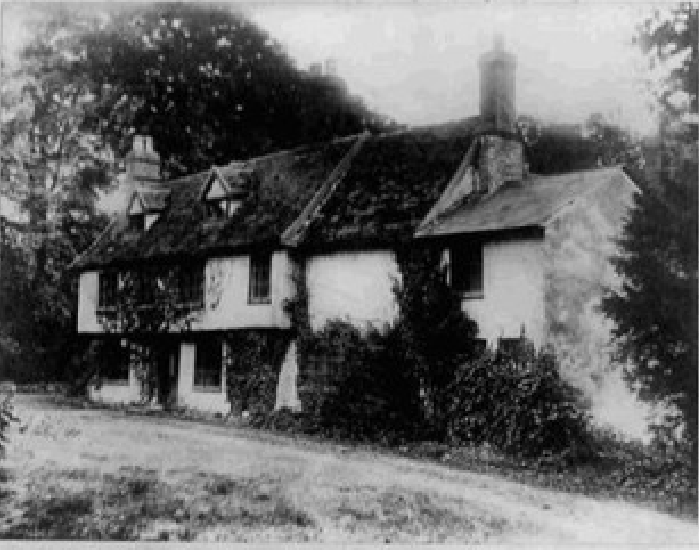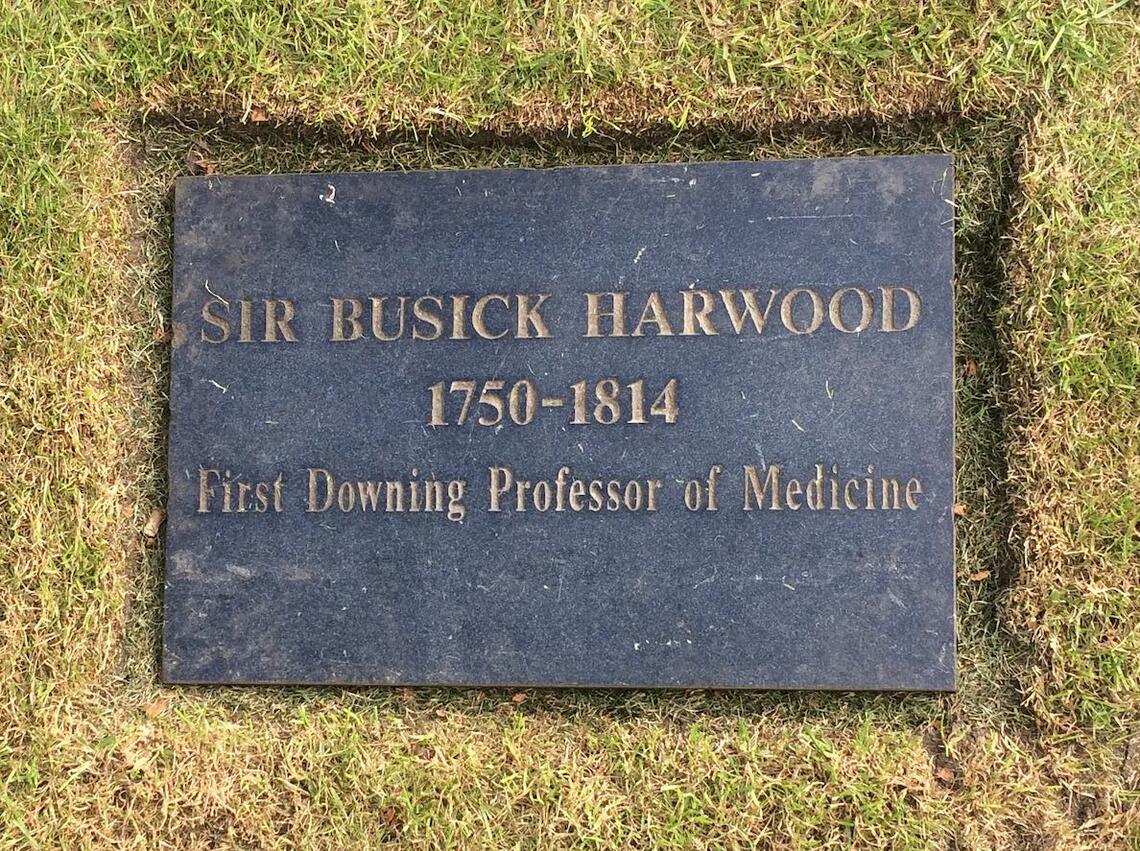Sir Busick Harwood (c1745- 1814) and, to a lesser extent, Rev. Joseph Hall (1753 – 1828) - by Gilly Cunningham
In 1802 a Cambridge Professor, Dr. Busick Harwood, moved into Bartlow House and became the neighbour of The Reverend Joseph Hall who lived at the Rectory. The Reverend Hall was the incumbent and Patron of the Living of St. Mary’s Bartlow and had been since 1782 – a saintly man by all accounts and well known for his charitable works.
There were only 5 people on the Poll Books eligible to vote in Bartlow at this time so the gene pool for dinner guests was pretty shallow – it was inevitable that Rev. Hall and Dr Harwood, would have to socialise. The two men were both Christ’s College men and Mrs. Harwood herself was a Parson’s daughter. They became friends and Dr. Harwood, who was both scientist and art collector, gave the Reverend one of his paintings.
But Dr. Harwood was known to be a rather difficult man and very different to the dear old Rector. His was a more colourful background – born in Newmarket and originally apprenticed to an apothecary he later qualified as a surgeon (a gruesome and not entirely respectable profession in those days). He made his fortune in the Indian Medical Service with a lucrative practice treating local princes and returned to England only because of ill health. His recently acquired wealth enabled him to study medicine at University – St. Andrew’s, Edinburgh then at Christ’s College, Cambridge. He graduated in the 1780s and subsequently became a Fellow of the Royal Society largely on the strength of his thesis on blood transfusions. He eventually became both the University’s Professor of Anatomy and Downing’s first Professor of Medicine – quite the brainbox!

He was described in a contemporary Cambridge Journal as a popular bon viveur “witty but very licentious in conversation”, “eccentric and quarrelsome”. Some of his squabbles involved his Art collection and he actually challenged Sir Isaac Pennington, Regius Professor of Physics, to a duel – illegal but still in vogue until the mid 1800s. Fortunately, sensible Sir Isaac ignored him but the student who delivered the challenge took the story to the London papers, which is, of course, how we know about it.
His star was definitely in the ascendant when he moved to Bartlow, recently married and on the brink of a knighthood, but it is difficult to imagine a less likely companion for Rev. Hall and the friendship didn’t last.
In 1806 the, by then, Sir Busick Harwood decided he wanted to re-draw the route of Churchway footpath to take it further away from his house and when Rev. Hall complained that this would lead people straight into the Rectory garden, Sir Busick ignored his protests and moved it anyway. He refused to discuss matters further. I believe the Churchway footpath is what we now know as Tin Alley which runs along the boundary between Bartlow House (now Bartlow Park) and The Rectory (now demolished), its garden having become part of the Churchyard.
Rev. Hall could see the new fence from his study window whilst writing his sermons, and this upset him. Sir Busick then rubbed salt into the wound by hanging a human skeleton from the fence – something he had no trouble acquiring in his line of work. Poor old Rev. Hall was beside himself. He must have felt powerless. He returned the picture he had been given but what else could he do? Well, he did what any red-blooded Englishman would do – he wrote a stiff letter
“Sir, You stand convicted by the verdict of everyone who has observed your behaviour of late, of the meanest conduct. Your very workmen blush for you, the passing villager speaks of you with contempt and the traveller sighs for you. My friends wonder that my acts of kindness and hospitality should be so obliterated from your memory but gratitude is a quality which never was your’s” (he was so cross he misused an apostrophe). He went on to suggest that “if he was ever in want of bread Dr. Harwood would have no trouble denying it him. The Christian edict ‘do as you would be done by’ would be a satire on the doctor if written on the corners of his house”.
Sir Busick’s response was swift and characteristically disproportionate to the affront. He issued a Writ in the Court of Kings Bench for criminal libel. Imagine the horror this would have caused dear old Rev. Hall and his household. He had no choice but to plead guilty at the first hearing and offered profuse apologies which were NOT accepted by Sir Besick. The case had to proceed and so the Reverend Hall listed the mitigating circumstances - the mortification he had suffered at Sir Besick’s hands citing the skeleton in particular. According to the Court records affidavits were filed by “a vast number of gentlemen both clergy and laity of the first distinction as to his excellent character as a Christian, a divine, a magistrate and a man”. But in the end the Rev. Hall was fined and had a criminal record for ever. The case was all over the newspapers, who then as now loved a story about a naughty vicar.
I am pleased to say Sir Busick left the village soon after – there is an advertisement for the sale of a substantial brick
mansion in the village in 1807. He took up the post of the first Vice Master of Downing College in about 1812, also becoming the first resident of the College where he subsequently died in 1814. Even his death caused a stir. He had made the College aware that, as one of its founders, he wanted to be buried in the vault under the Downing College Chapel. Unfortunately, it was yet to be built so he was temporarily buried under a lawn awaiting the eventual building of the vault and chapel around him. His burial place remained unmarked for many years as the College Chapel was not built until 1953! Someone must have remembered where they put him eventually as a plaque was laid in 1987.
Intriguingly, the Information Board at The Three Hills site in the Village tells us that Sir Busick Harwood was the instigator of the original excavation of the tumuli in 1815 (a thoughtless project which resulted in the loss of most of the evidence and artefacts). Either there is a mistake in the dates or this was a posthumous project or Besick Harwood had nothing to do with it all. Yet another Three Hills conundrum!
The Rev. Hall outlived Sir Busick for 14 years and on his death at The Rectory at the age of 75 he left a wonderfully detailed will which confirmed the character of the man. The will made provision for his cook, his footman, his servant, Elizabeth, and his gardener. It provided for his widowed sister and his niece before setting up a trust of 19 guineas (currently worth just over £2,000) for the relief of the poor of the village. The residue of the estate including the perpetual avowson and patronage of St. Mary’s Church, the Rectory, the glebe lands, tithes and appurtenances, went to his nephew, John Bullen, who succeeded him as Rector of Bartlow. Rev. Joseph Hall is buried somewhere in St. Mary’s Churchyard.



